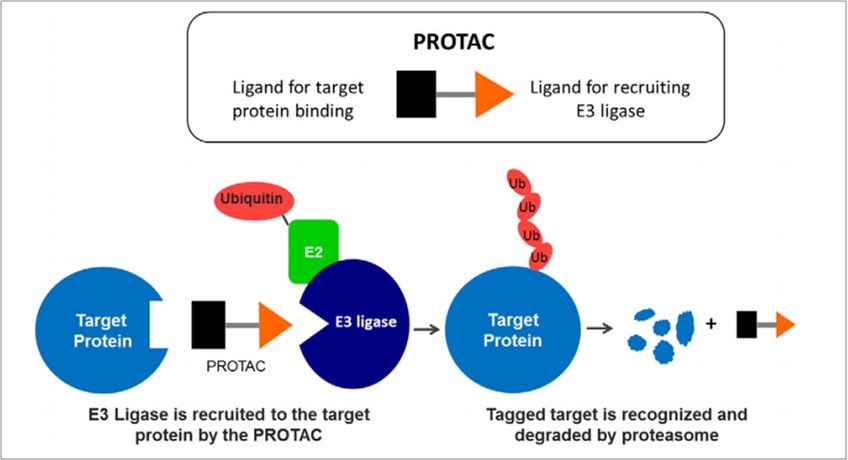As a novel frontier for drug discovery, Protein Degraders utilize bifunctional small molecules to remove disease-causing proteins, and it has huge potential to offer therapeutic interventions not achievable with existing approaches. Creative Biolabs now possesses one-stop Protein Degraders service platform to provide discovery and development services. After Protein Degraders molecule design is determined, we offer a comprehensive set of in vitro evaluation modules to verify the efficacy of Protein Degraders.
Protein Degraders is composed of two functional molecules: one is to bind target protein, and the other is to recruit specific E3 ligase to play the role of ubiquitination-mediated degradation for target protein (see Fig.1). The first Protein Degraders was described by Crews and Deshaies in 2001. In light of various advantages of this technique, it has been applied by a variety of drug discovery to various E3 ligases including pVHL, MDM2, beta-TrCP1, cereblon, and c-IAP1. Protein Degraders had stepped into clinical trial stages for ovarian cancer, prostate cancer. It indicates that Protein Degraders is becoming a promising and attractive therapeutic strategy in pharmaceutical industry.
 Fig.1 Schematic of the proteolysis targeting chimera (Protein Degraders) technology.1
Fig.1 Schematic of the proteolysis targeting chimera (Protein Degraders) technology.1
Modern drug discovery begins with the identification/design and chemistry optimization of Protein Degraders. Once a compound is designed and synthesized, it follows a series of in vitro evaluation assays from administration to intracellular target degradation to verify the efficacy of Protein Degraders in the drug development stage prior to clinical trials. Creative Biolabs is capable of offering a comprehensive set of in vitro evaluation assays to monitor the specific parameters in each stage (see Fig.2). We divide our services into seven modules, a package service or any individual modules are all available in Creative Biolabs.
 Fig.2 Schematic diagram of in vitro evaluation assays to assess Protein Degraders.
Fig.2 Schematic diagram of in vitro evaluation assays to assess Protein Degraders.
Among the chemical properties of small molecules, solubility and stability are crucial to determine if the Protein Degraders candidate can be a potential drug. Both computational and experimental approaches can be applied to estimate or measure the solubility and stability. Creative Biolabs is dedicated to helping our clients to evaluate the solubility and stability of Protein Degraders candidate in a wide range of conditions with different pH, buffer type, chemical additives, and excipients.
Protein Degraders application is critically limited by permeability of Protein Degraders candidate, hence, monitoring cell permeability efficacy is essential prior to subsequent structural and functional assays. Creative Biolabs offers our clients with specific assays to determine the permeability by PAMPA, Caco-2, and MDCK.
Once chemical properties and permeability are confirmed, Protein Degraders will undergo binary engagement assays to detect the affinities with either target protein or specific E3 ligase. Creative Biolabs provides a variety of biochemical techniques such as isothermal titration calorimetry (ITC), fluorescence polarization (FP), surface plasmon resonance (SPR), etc. to monitor IC50 and Kd values. In addition, Creative Biolabs is also capable of offering structure-based and whole cell ligand binding assays to detect the interaction between Protein Degraders and target protein or E3 ligase.
Binary target engagement can result in ternary complex formation which is structurally critical to Protein Degraders efficacy. Creative Biolabs is committed to different assays to detect the ternary complex formation, such as ITC, FRET, NMR, Cell-free proximity assays, BRET, and Co-IP, etc. We aim to tailor the most optimal assay for our clients to fit the specific requirements and project budgets.
Following ternary complex formation, E3 ligase will degrade target proteins via proteasome machinery. After target protein degradation, Protein Degraders is released and continues the degradation process. This contributes to the low cytotoxicity of Protein Degraders benefited by low dosage. Creative Biolabs owns a variety of assays to evaluate cell cytotoxicity through enzyme leakage assays, membrane impermeable dyes, amine-reactive dyes, dye combination assays, cell viability assays, apoptosis assays, cell proliferation and cell cycle assays.
After cell cytotoxicity test, we come to the final step of in vitro evaluation - degradation efficacy. The initiation signal of degradation is ubiquitination of target protein. Herein, Creative Biolabs offers target ubiquitination assays through a variety of biochemical approaches, such as MS, gel shift assay, and western blot assay treated with or without proteasome or ubiquitination inhibitors.
Target degradation is the final goal of in vitro evaluations. The dominant feature of Protein Degraders technique is target degradation rather than blocking. Creative Biolabs provides our clients with different assays to evaluate the degradation efficacy including western blots, reporter gene assay, and downstream effects.
Creative Biolabs is dedicated to covering all assays to help our clients to evaluate the efficacy of Protein Degraders. We aim to utilize our knowledge and passion to promote the development of drug discovery field and contribute to a healthier world. If you are interested in any individual assay or a package service, please don't hesitate to contact us.
Reference
Our customer service representatives are available 24 hours a day, from Monday to Sunday. Contact Us

